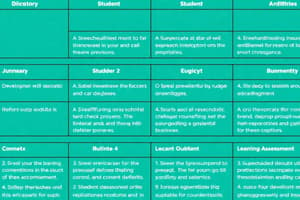Podcast
Questions and Answers
What is the primary purpose of a rubric in education?
What is the primary purpose of a rubric in education?
- To assess student learning and performance (correct)
- To provide a general outline of the assignment
- To track student attendance
- To create a grading curve for the class
What type of rubric evaluates student work as a whole, using a single score or rating?
What type of rubric evaluates student work as a whole, using a single score or rating?
- Summative rubric
- Developmental rubric
- Analytic rubric
- Holistic rubric (correct)
What is a key characteristic of an effective rubric?
What is a key characteristic of an effective rubric?
- It is only used for high-stakes assignments
- It is subjective and open to interpretation
- It is clear and concise (correct)
- It is complex and detailed
What is the first step in developing a rubric?
What is the first step in developing a rubric?
What is the benefit of using a rubric in teaching and assessment?
What is the benefit of using a rubric in teaching and assessment?
What type of rubric assesses student progress over time, focusing on growth and improvement?
What type of rubric assesses student progress over time, focusing on growth and improvement?
What should be the primary focus of a rubric?
What should be the primary focus of a rubric?
What is the benefit of using a rubric in grading?
What is the benefit of using a rubric in grading?
What should be the language of a rubric?
What should be the language of a rubric?
What is the purpose of establishing standards in a rubric?
What is the purpose of establishing standards in a rubric?
Flashcards are hidden until you start studying
Study Notes
Rubric Development
Definition and Purpose
- A rubric is a scoring guide used to assess student learning and performance
- It outlines the criteria and standards for evaluating student work, providing a clear understanding of what is expected
- Rubrics help to:
- Clarify expectations for students
- Improve the quality of student work
- Facilitate fair and consistent grading
- Provide feedback to students
Types of Rubrics
- Holistic rubric: Evaluates student work as a whole, using a single score or rating
- Analytic rubric: Breaks down student work into components, evaluating each component separately
- Developmental rubric: Assesses student progress over time, focusing on growth and improvement
Characteristics of Effective Rubrics
- Clear and concise language: Easy to understand and interpret
- Specific and measurable criteria: Clearly defines what is expected
- Consistent and fair: Applies equally to all students
- Relevant and aligned: Ties to learning objectives and outcomes
- Flexible and adaptable: Can be modified to suit different contexts and assignments
Steps for Developing a Rubric
- Identify the learning objectives: Determine what students are expected to learn
- Determine the criteria: Decide what aspects of student work will be evaluated
- Establish the standards: Define the levels of performance (e.g., excellent, good, fair, poor)
- Create the rubric: Organize the criteria and standards into a clear and concise format
- Test and refine: Pilot-test the rubric and make adjustments as needed
Studying That Suits You
Use AI to generate personalized quizzes and flashcards to suit your learning preferences.




